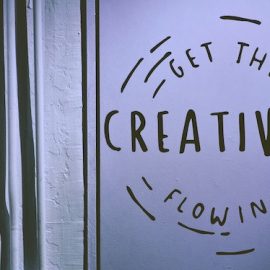

This article is an excerpt from the Shortform book guide to "Bold" by Peter H. Diamandis and Steven Kotler. Shortform has the world's best summaries and analyses of books you should be reading.
Like this article? Sign up for a free trial here.
What creative habits should you get into? How can these habits create fresh and exciting ideas?
In Bold, Peter Diamandis and Steven Kotler present a number of strategies that successful innovators rely on to come up with ideas, products, and services that change the world. Their recommendations can be condensed into four main habits.
Let’s explore the four creative habits that you should pick up.
Habit #1: Back Your Innovations With Far-Reaching and Purpose-Driven Goals
The first creative habit the authors recommend is backing your innovations with far-reaching and purpose-driven goals. A far-reaching goal is so big that it seems nearly impossible to the average person. Creating far-reaching goals will hinge on Strength #1: the ability to think unconventionally and autonomously. A purpose-driven goal aligns with your values and aims to accomplish something higher than its basic purpose. Creating purpose-driven goals will hinge on Strength #3: knowing your purpose.
For example, imagine that your innovation is a service that connects people who want to care for animals to animals in need. The far-reaching and purpose-driven goal inspiring that innovation might be to reduce the number of homeless, malnourished, abused, and injured animals in the world. This is an extremely ambitious goal that has a higher purpose of making the world a better, more humane place.
Backing your innovations with far-reaching and purpose-driven goals is crucial because these innovations are the most impactful—the kind that change the world in some way.
Create a Company Vision
The Bold authors argue that you must create far-reaching, purpose-driven goals to drive your innovations and, ultimately, achieve success. In Traction, Gino Wickman makes a similar argument. He sees setting these goals as two steps to creating a defining vision for your company that will lead to its success. Here’s Wickman’s full process for creating a defining vision:
- Come up with a list of defining values for your company.
- Create a 10-year goal (the far-reaching goal that Bold’s authors recommend), a three-year goal, and a one-year goal for your company.
- Create a marketing strategy based on your core focus (the purpose underlying your company’s mission or your innovation, similar to Diamandis and Kotler’s purpose-driven goals).
- Identify priorities for the next 90 days that will help you move toward your far-reaching goal and that align with your purpose.
- Identify the issues preventing you from reaching your goals.
Habit #2: Create Micro-Goals That Build Your Credibility
The authors recommend breaking down your end goal of having a successful, world-changing innovation into micro-goals: smaller achievements intended to pave your way toward success by building credibility.
Having high credibility is crucial to success because it makes outside stakeholders, like customers and critics, see your innovation as likely to succeed. And once your innovation goes public, these stakeholders are the ones who’ll determine your success—they’ll either endorse your product, leading to success, or they’ll be unimpressed and you’ll fade into the background.
To help identify your micro-goals, consider the steps necessary to complete your innovation and gain credibility in the industry: Are there any skills or abilities you must demonstrate to the public? Any important contacts or supporters you should acquire?
For example, if your end goal is to establish an online platform that connects people who want to care for animals to animals in need, a few of your micro-goals might be:
- Hold a conference to discuss animal welfare and invite people and organizations dedicated to the cause, such as veterinarians, animal shelters, welfare societies, farms, and pet foster parents.
- Raise $1,000 every month to donate to animal welfare societies.
- Create a user-friendly website where members can sign up to either adopt an animal or advertise for an animal in need.
Ultimately, your micro-goals will build a track record that shows the public that you’re credible—you know what you’re doing, you’ve succeeded in the past, and you have other credible people supporting you.
Build Credibility by Starting With Your Online Presence
Business experts generally agree that building credibility, and setting sub-goals to do so, is one of the best ways to achieve success and public acceptance as an entrepreneur. However, in today’s age of social media, some experts argue that the best way to gain success is to focus your micro-goals on improving your online image’s credibility. This is because consumers are most likely to support products based on how they appear online and on social media. It only takes 0.05 seconds for someone to make their mind up about the product, so it’s crucial that your public image screams “credible!”
Experts make a few recommendations for creating micro goals that, when accomplished, will give your idea a credible online public image:
- Perform a SWOT analysis of yourself and your brand to determine which strengths you can use to improve your credibility, which weaknesses are holding you back, which opportunities you can take advantage of to boost your credibility, and which threats might get in your way.
- Update your social media accounts with new photos and bios that are authentic and showcase your values. Ensure that these images and bios are consistent across all your accounts.
- Clearly showcase stats that will boost your credibility, using numerical figures specifically. For example, rather than tweeting something like “Eight thousand people logged on to our platform in the last day,” say “8,000 people logged on to our platform in the last 24 hours.” Words are less awe-inspiring than numbers.
- Create partnerships with other credible people and brands in your industry. You can do this by attending online events or webinars.
Habit #3: Work in a Controlled Environment
The authors explain that the best innovations occur in environments that are closed from the outside world and only allow access to a select few who share your innovator’s mindset. This is because these environments encourage unconventional, autonomous thinking and risk-taking—as we’ve noted, two psychological strengths necessary for innovation. On the other hand, exposure to the predictability and doubts of wider society hinders these strengths.
(Shortform note: While the Bold authors focus on who is in your environment, the setup of that environment is arguably just as important. Research shows that changing a few environmental factors might boost your innovative potential even more: for example, including random items around the environment for inspiration, using moderate levels of ambient background noise, decorating the space with creative colors like green and blue, and using softer lighting rather than bright overheads. These changes will boost your creativity and help you think outside the box—crucial elements for successful innovation.)
Habit #4: Experiment Constantly
Finally, innovators must put their psychological strength of being comfortable with risk-taking and failure into action by constantly experimenting. The authors note that you must repeatedly experiment and fail before you can find a strategy or idea that works. The more experiments you conduct, and the more frequently you conduct them, the faster you’ll determine what works and the more progress you’ll make toward your goal.
(Shortform note: In The Confidence Code, Katty Kay and Claire Shipman agree that experimenting constantly and failing often are crucial to uncovering the best ideas. They also argue that experimenting and failing are crucial to building confidence—in their view, the true key to becoming successful. Confidence is crucial for success because it turns desire and skill into actions that lead to success. Other techniques that will help you build confidence, and arguably improve your experimentation abilities, are 1) choosing action over stagnation, even when the action is risky; and 2) practicing thought exercises that encourage positive thinking and prevent rumination that might slow you down.)

———End of Preview———
Like what you just read? Read the rest of the world's best book summary and analysis of Peter H. Diamandis and Steven Kotler's "Bold" at Shortform.
Here's what you'll find in our full Bold summary:
- How to become a successful entrepreneur and maintain your success
- The three steps to becoming an innovator
- The psychological strengths needed to handle the high-stress commitment to innovation






